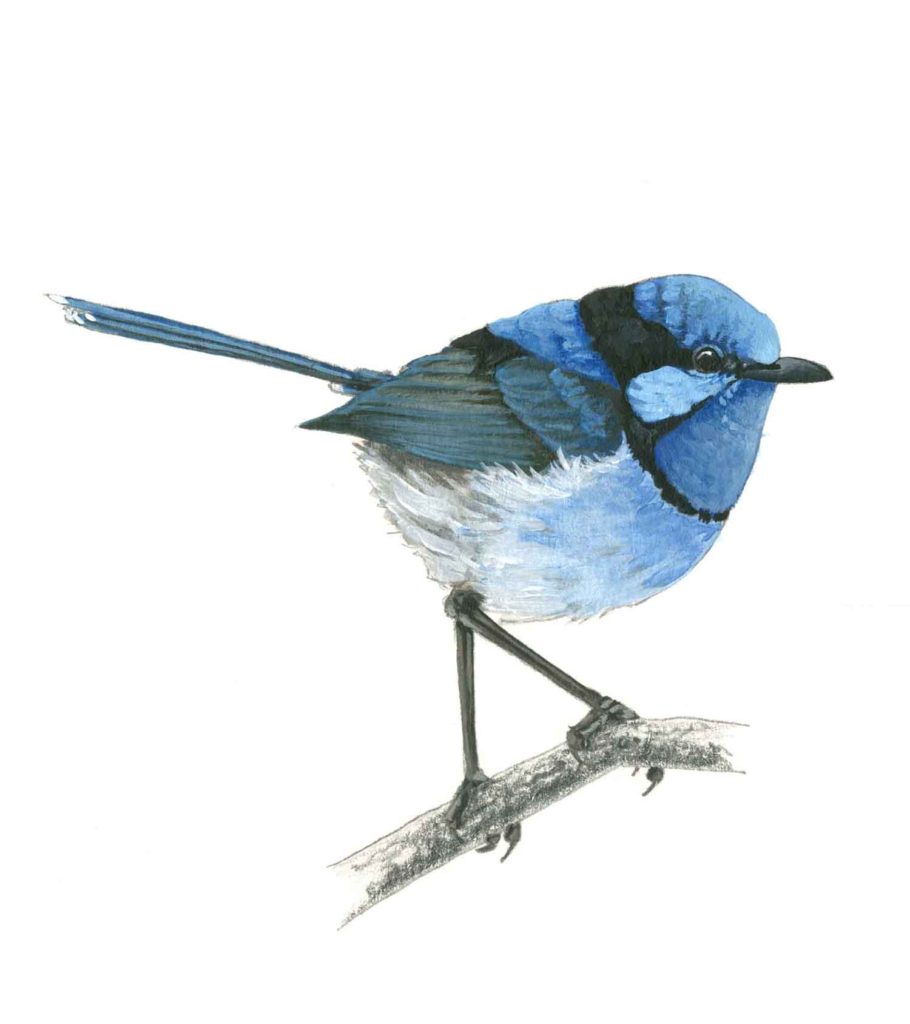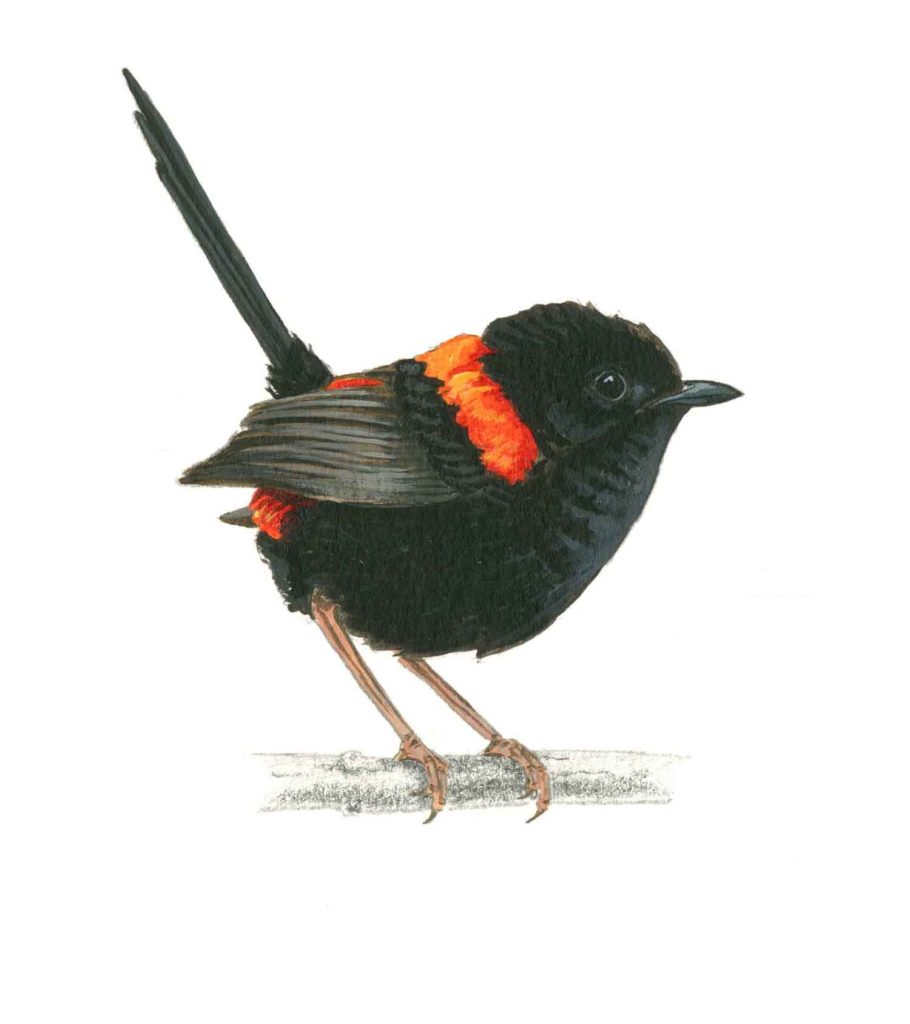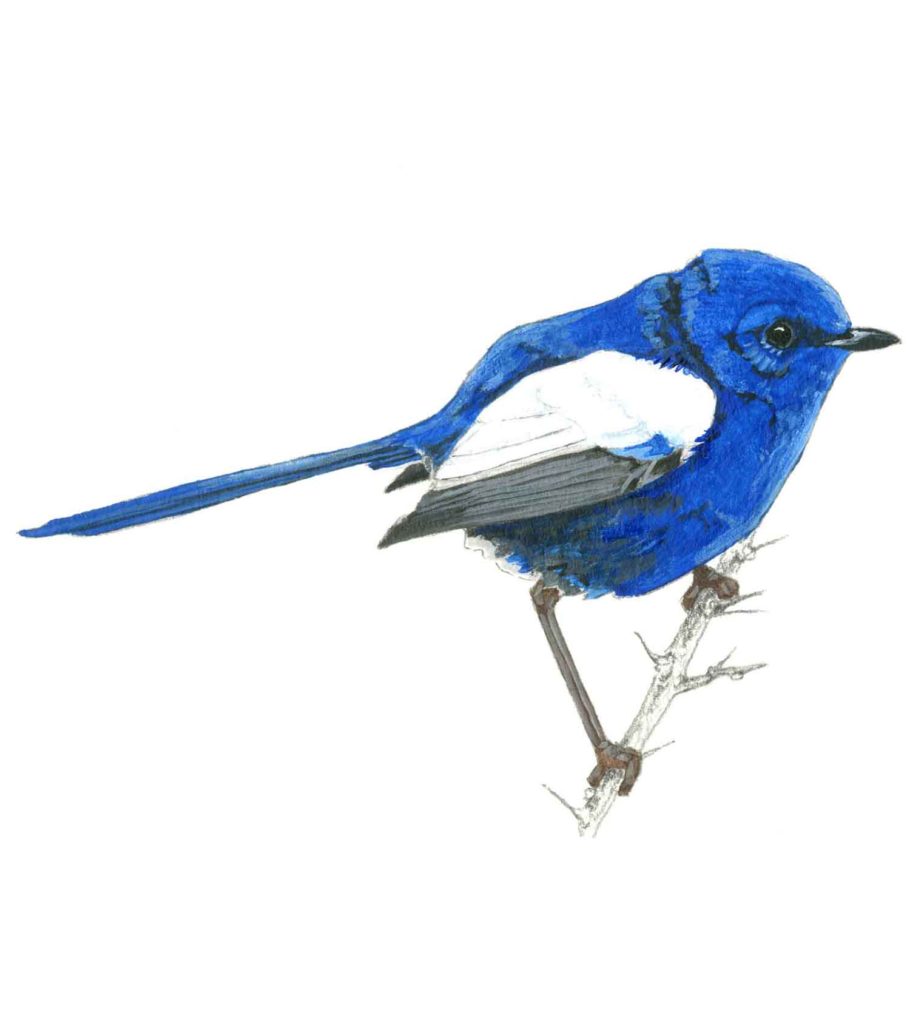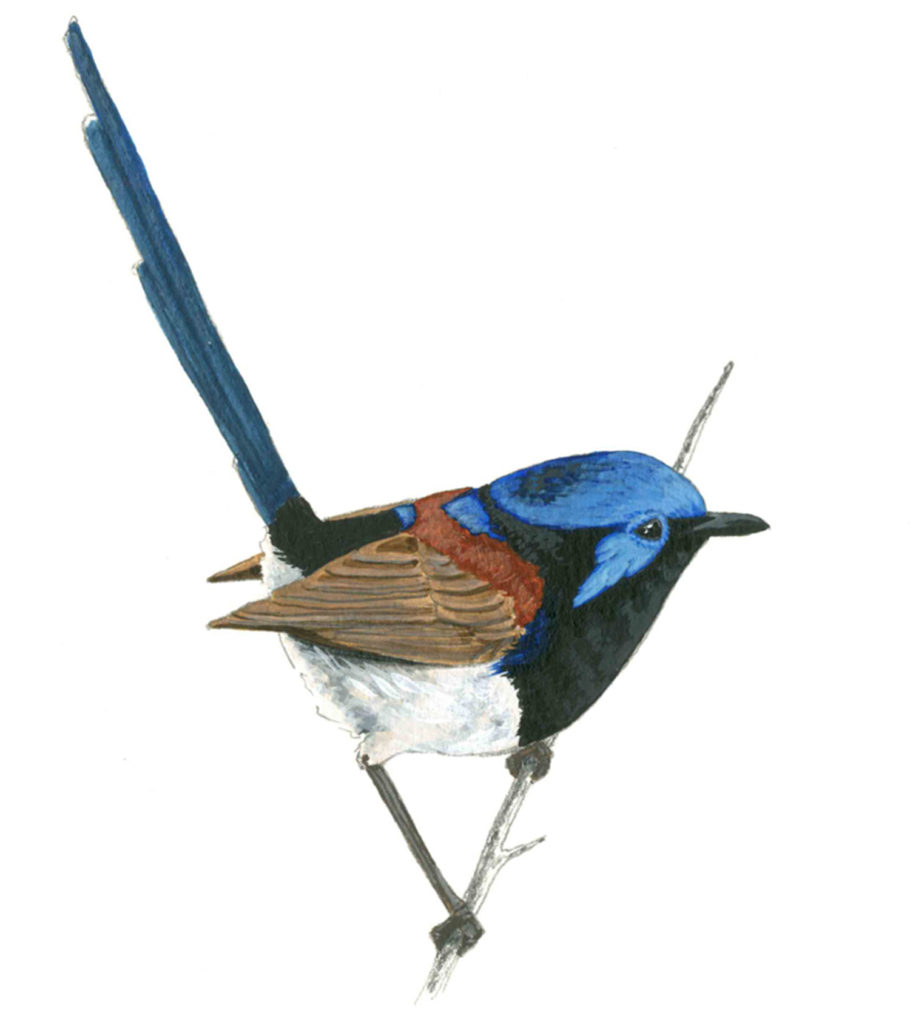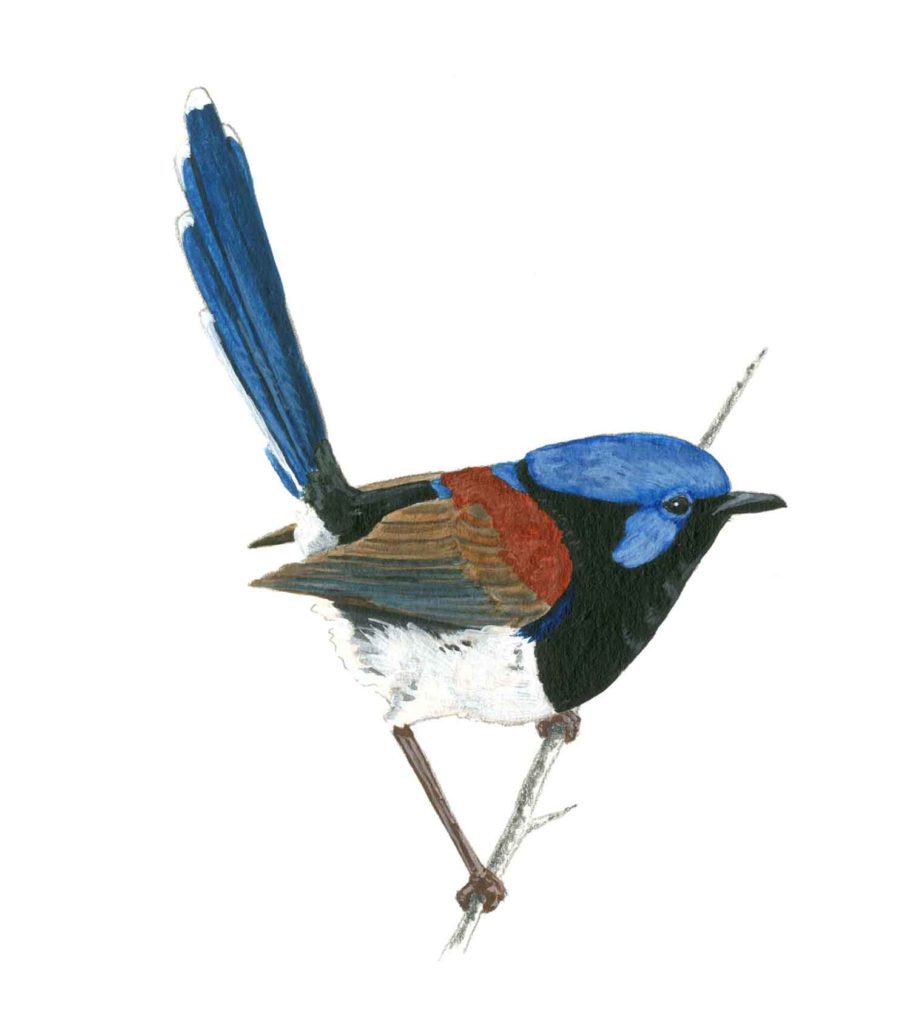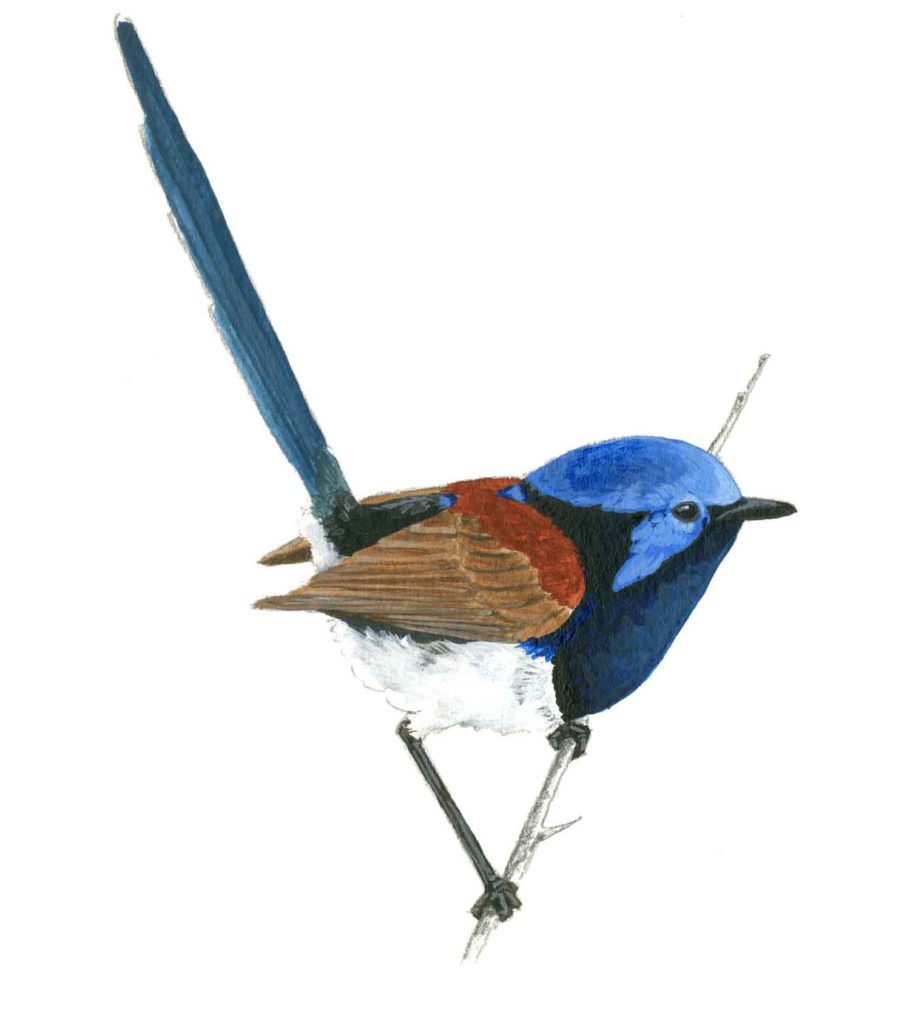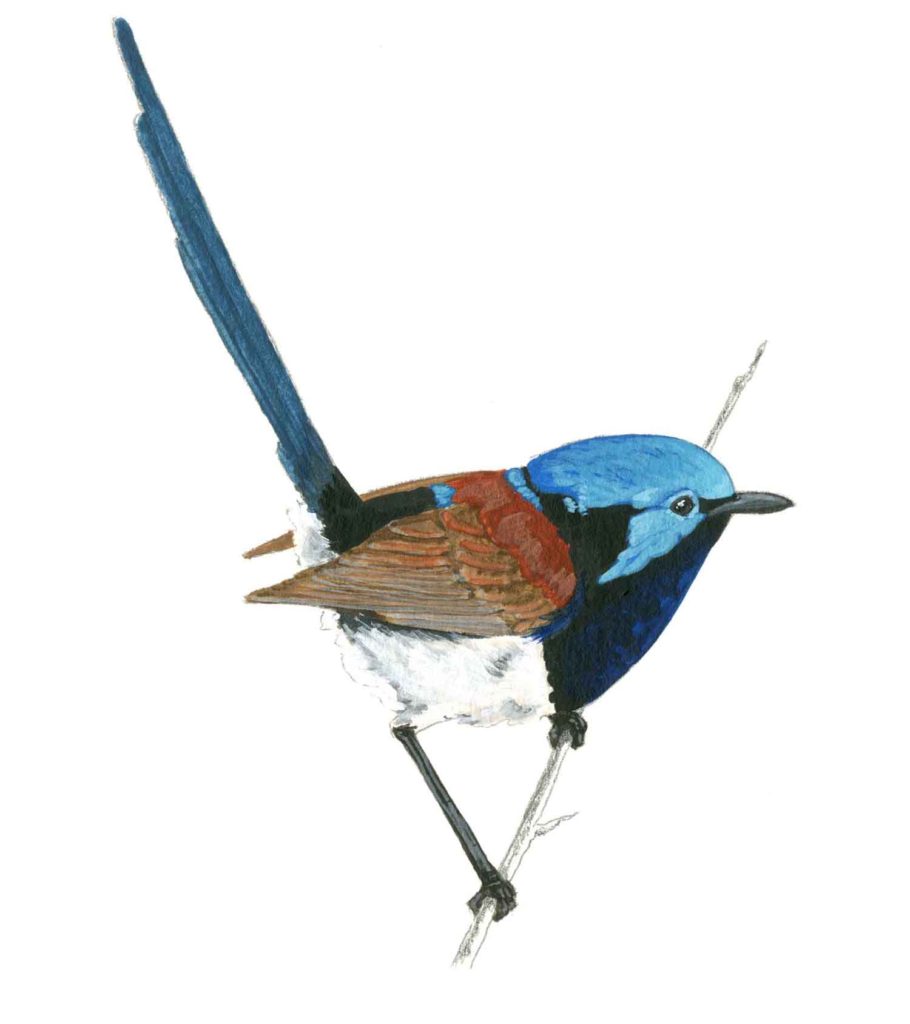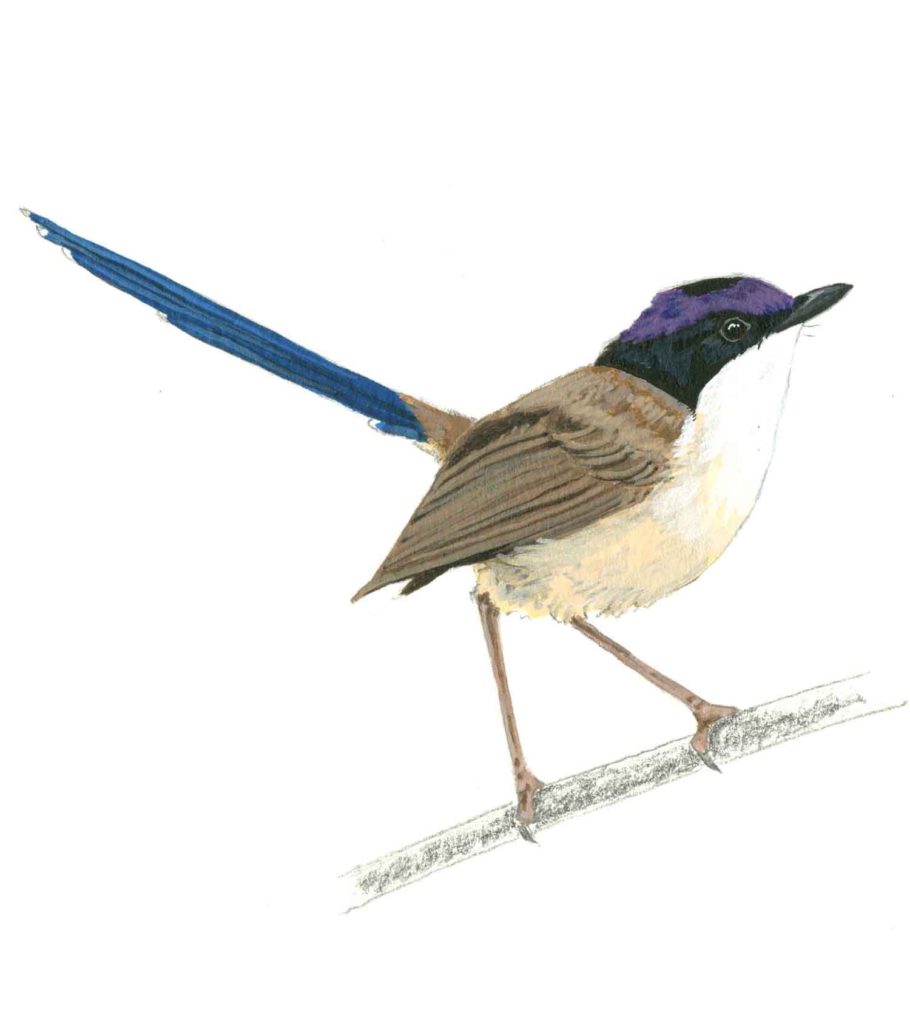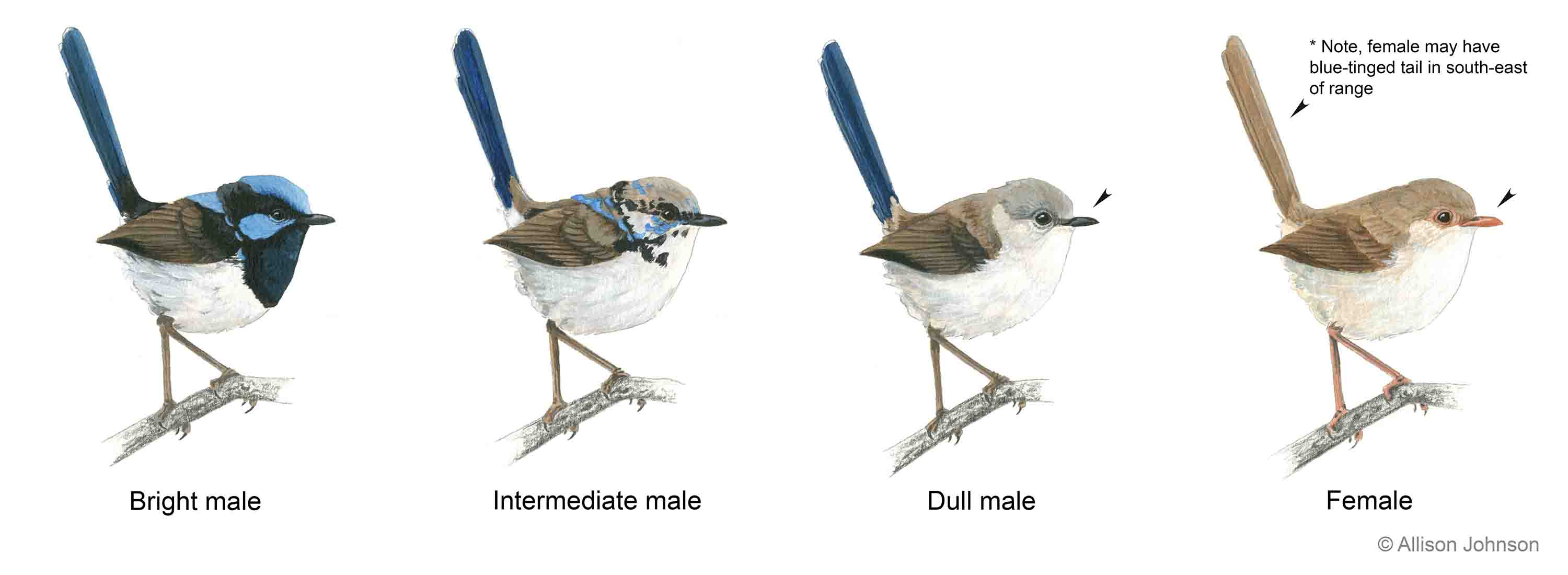
Known and loved by Australians and gift-shop-visiting tourists alike, Superb Fairywrens may be one of Australia’s most well-known birds. This charismatic species is as likely to be found in back gardens and botanical gardens as it is on vegetated roadsides throughout south-eastern Australia.
Bright Male Plumage: Pale blue top of head and cheeks separated by a stripe of black that runs through the eye and around the nape of the neck. Deep blue breast and throat are ringed by black. Tail similarly deep blue. Belly is stark white. Upper back is pale blue, bill and lower back are black.
Intermediate Plumage: Brown plumage interspersed with bright plumage all over body, especially on head. Tail is deep blue.
Dull Male Plumage: Brown back with white breast and belly.To distinguish from female, look for black bill and lack of rufous-brown eye lores.
Female and Juvenile Plumage: Plumage as dull male except rufous-brown eye lores that extend from bill of same color. Tail brown throughout most of range, becoming slightly bluer in southeastern South Australia.
Voice: Macaulay Library
Photographs: Macaulay Library
Explore Sightings: eBird
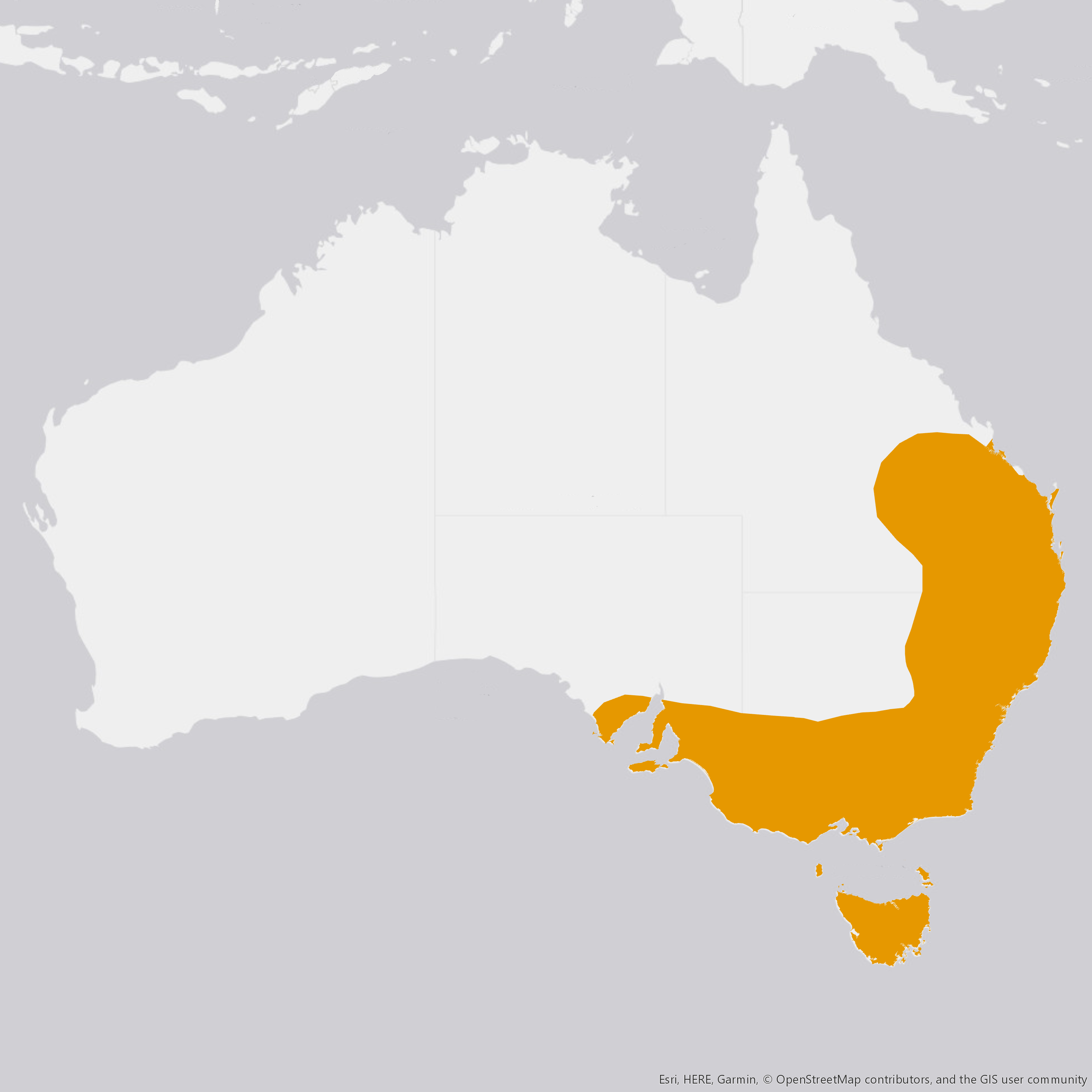
Superb Fairywren range

Splendid fairywrens are bold, brilliantly plumed birds that are often found perched high on a bare branch surveying their territories. They have a large range, found throughout eastern, central, and western Australia in mallee eucalyptus woodlands. The Splendid Fairywren is divided into three subspecies, M. s. melanotus in the east, M. s. callanius in the center of the country, and M. s. splendens in the south-west. Males can be seen wooing extra-pair females, presenting yellow or purple flower-petals and fanning their cheek feathers out to potential mates. Bobbing seahorse flights are common as males leave territories they have intruded into.
Bright Male Plumage: Head, shoulder, breast bright royal-blue. Cheeks a brighter, iridescent sky-blue. Black harness through eye, around the cheeks and back of head, connecting to a band around the breast. Tail blue. M. s. splendens has blue back and belly; M. s. melanotus has black lower back and white lower belly that becomes bluer as they age; M. s. callanius more turquoise than other subspecies, belly blue and lower black back.
Intermediate Plumage: Dull plumage is interrupted by bright blue plumage throughout the body, for a patchy appearance. Bill black. Belly is often the last to turn blue when molting into bright plumage.
Dull Male Plumage: Grey-brown head, back, with grey-white belly. Tail and wing feathers blueish. Black lores extending from black bill.
Female and Juvenile Plumage: Grey-brown head, back, and wings, belly lighter grey-white. Tail dull turquoise. Lores and eye ring light rufous-brown extending from bill of same color.
Voice: Macaulay Library
Photographs: Macaulay Library
Explore Sightings: eBird
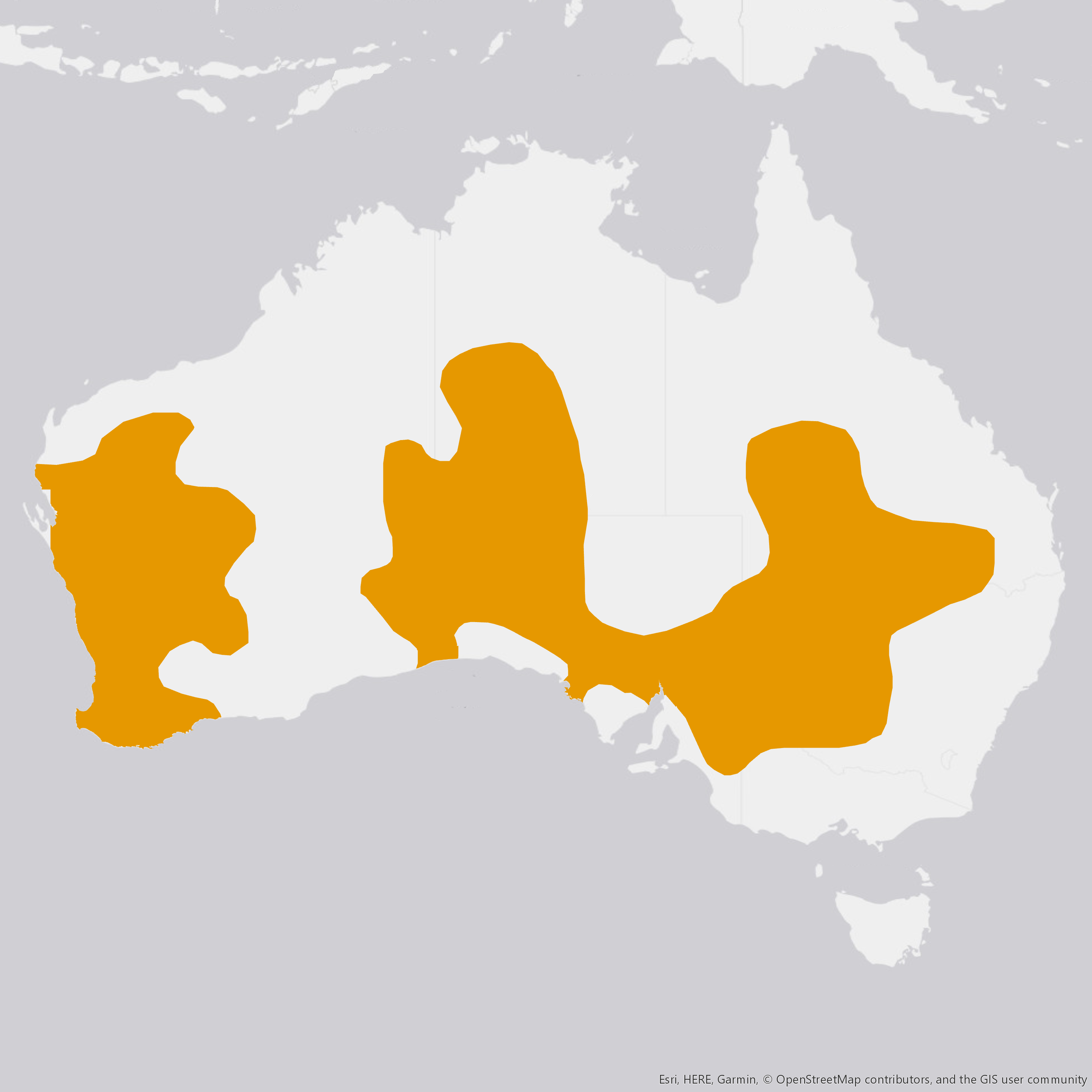
Splendid Fairywren range

Red-backed fairywrens are common throughout northern and eastern Australia where open grassland and forests with grass understory occur. Males in bright plumage can often be seen pursuing females across the Australian savanna with red back feathers raised high. Dull males and females are indistinguishable during most of the year. The Red-backed Fairywren is split into two subspecies, M. m. cruentatus in the north of the range and M. m. melanocephalus in the east, split by the Carpentarian Barrier.
Bright Male Plumage: Jet black body and tail with a bright red/orange patch on shoulders and back. Flight feathers of wing remain brown even in fully-bright males. Bill is always black. M. m. cruentatus has darker red back than the red-orange back of M. m. melanocephalus.
Intermediate Male Plumage: Back, head, and breast typically begin molting first, often resulting in a very speckled bird. Rump and belly region are typically last to molt. Bill is typically black or almost black.
Female, Juvenile, and Dull Male Plumage: Fawn brown back, head, and tail with a creamy-white breast and belly. Bill color is typically light pink but dull breeding male may have black bill. The difference in bill color can be so slight that dull males and females are best classified as Unknown Dull.
Voice: Macaulay Library
Photographs: Macaulay Library
Explore Sightings: eBird

Red-backed Fairywren range
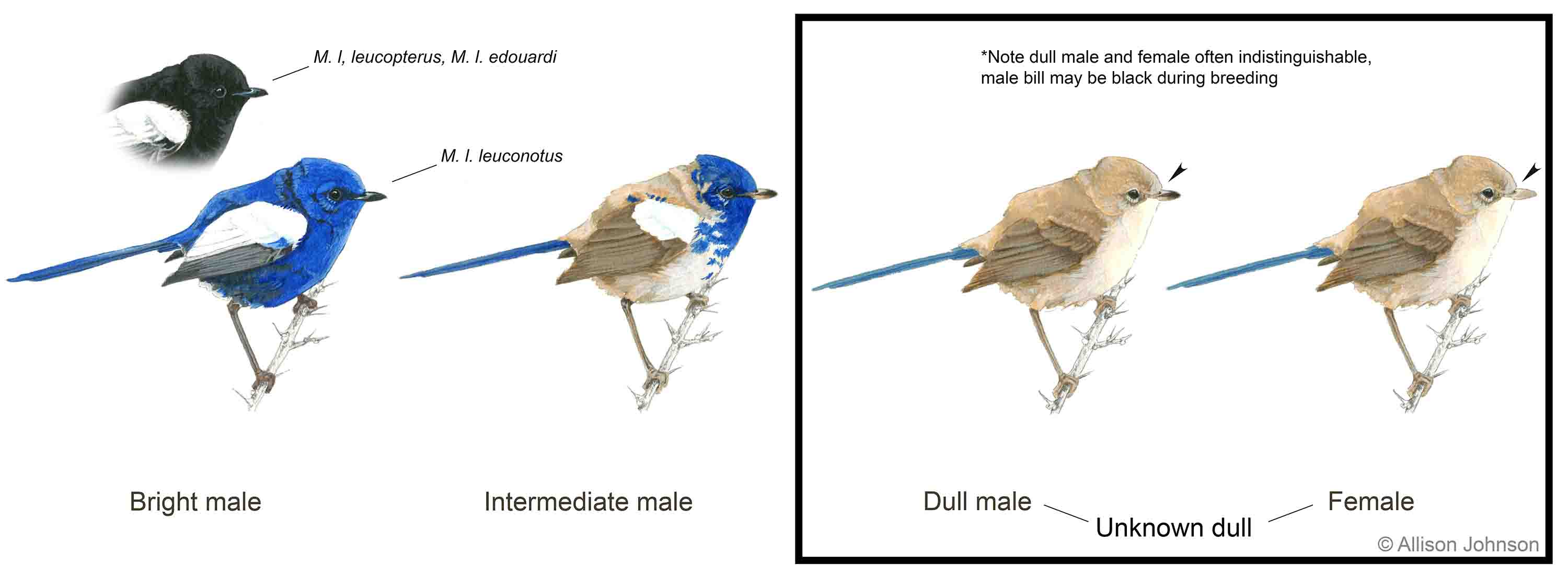
The striking White-winged Fairywren can found throughout central and western Australia in short, arid scrubland. Two distinct subspecies inhabit islands off the coast of Western Australia, M. l. leucopterus on Dirk Hartog Island and M. l. edouardi on Barrow Island. Unlike the intense blue breeding plumage of the mainland subspecies (M. l. leuconotus), the island males are characterized by deep black body feathers. Males may remain in dull plumage, indistinguishable from females, for up to four years before moulting into bright breeding plumage.
Bright Male Plumage: Mainland subspecies (M. l. leuconotus) males have deep blue body feathers with a brilliant white wing patch (scapular, secondary wing covert, and inner secondary feathers). Island subspecies bright males (M. l. leucopterus and edouardi) are similar, but body feathers are deep black rather than blue.
Intermediate Male Plumage: Males typically begin to moult into bright plumage in their third year and may remain in an intermediate stage for over a year. Males usually develop bright white wing patches first, followed by spotty blue or grey plumage throughout the body. The bill of intermediate males becomes black.
Female, Juvenile, and Dull Male Plumage: Similar to Red-backed Fairywren females, female White-winged Fairywrens have a light brown back and head, with grey-brown wings and a creamy-white breast and belly. Tail has blue tinge. Bill and legs are light pink-brown. Bright males in non-breeding plumage look similar but with black bills. Females of all subspecies look similar.
Voice: Macaulay Library
Photographs: Macaulay Library
Explore Sightings: eBird

White-winged Fairywren range
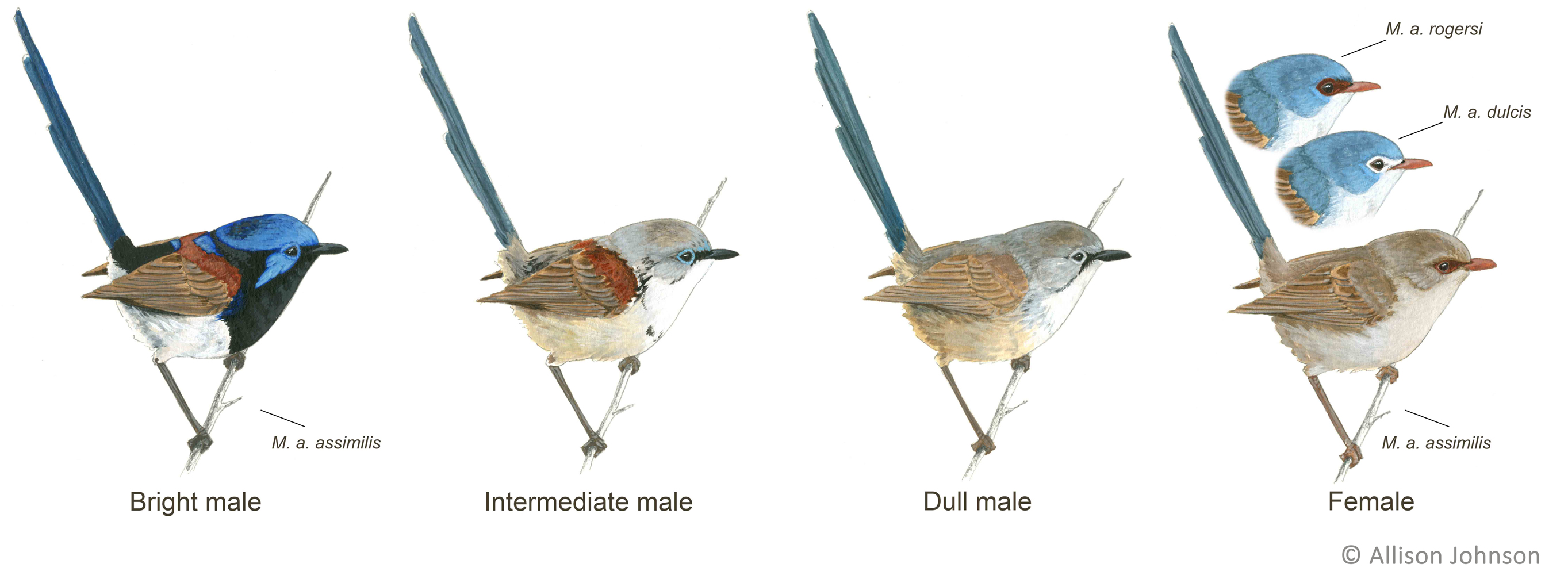
Extremely vocal and gregarious, the Purple-backed Fairywren has the largest range of all the Australian fairywrens, found throughout nearly the entire continent and overlapping extensively with several other fairywren species. This species is divided into four subspecies, M. a. assimilis (widespread, interior), M. a. bernieri (Bernier Island, WA), M. a. rogersi (Kimberly Range) and M. a. dulcis (Arhnem Land). They are often seen foraging in dense scrub habitat or in low tree canopies.
Bright Male Plumage: Bright blue crown with lighter blue cheeks and eye-ring. Bill, lores, breast, nape, and lower back black. Upper back and sides of breast dark blue. Wings brown, with rufous scapulars. Tail blue-grey and belly creamy-white. Bright males are similar across sub-species.
Intermediate Male Plumage: Intermediate plumage varies dramatically across individuals. Most helper males retain an intermediate plumage throughout their first breeding season but can rapidly develop full bright plumage if they disperse and establish their own territory. Males moulting into bright plumage for the first time may look similar to females (fully brown in M. a. assimilis and M. a. bernieri or blueish in M. a. rogersi or M. a. dulcis) but have no distinct lores or develop black lores and a blue eye ring. A blue eye ring suggests a bird in intermediate plumage. Males who have gone through a bright moult previously will already have black lores. Blue in crown and cheeks will moult in patchily as will the black breast. Bill is black or turning black.
Dull Male Plumage: Grey-brown head, back, and wings with creamy throat, tan belly, and blue-grey tail. Similar in appearance to female plumage but bill and lores are black.
Female and Juvenile Plumage: M. a. assimlis and M. a. bernieri females have grey-brown head, back and wings with creamy throat and tan belly. Tail blue-grey. Dark rufous lores and eye ring extending from a slightly lighter rufous bill. Legs grey-pink. M. a. rogersi and M. a. dulcis similar to one another, with bright white breast and belly, brown wings and blue-grey head, shoulders, back, and tail. Both have light rufous bills with either rufous lores and eye-ring (M. a. rogersi) or white lores and eye-ring (M. a. dulcis).
Voice: Macaulay Library
Photographs: Macaulay Library
Explore Sightings: eBird
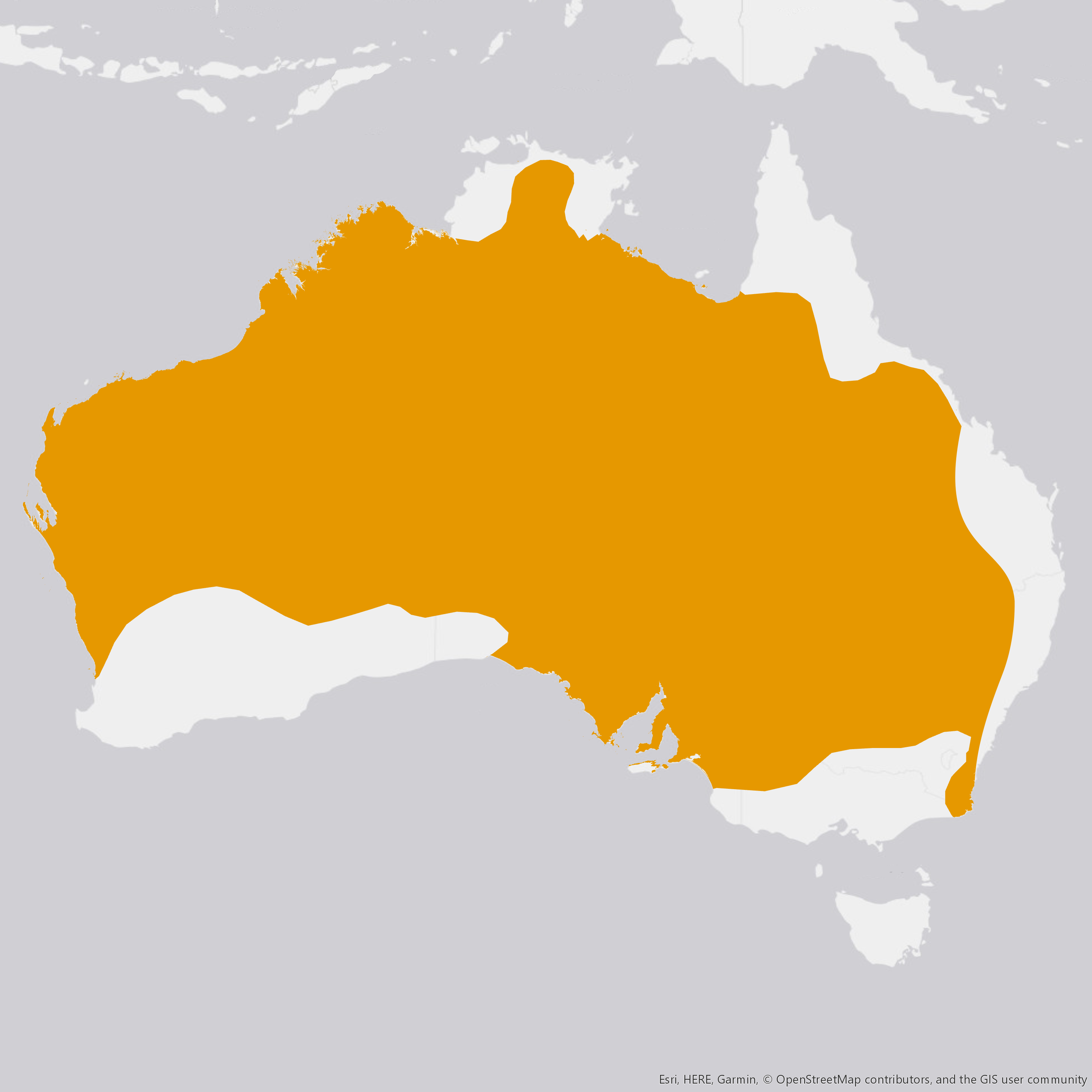
Purple-backed Fairywren range
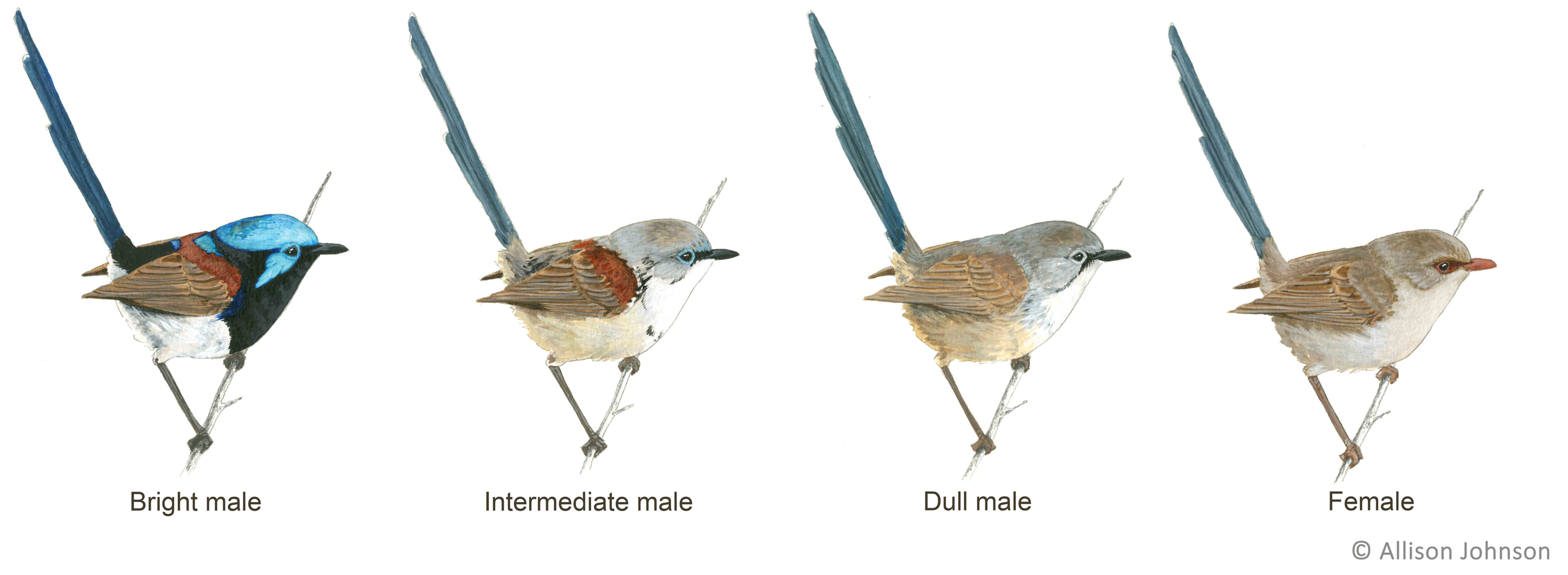
Recently split from what is now called the Purple-backed Fairywren, the Variegated Fairywren is restricted to coastal southeastern Australia, east of the Great Dividing Range. Variegated Fairywrens are very similar in both appearance and behavior to the related Purple-backed Fairywrens.
Bright Male Plumage: Bright turquoise-blue crown with turquoise cheeks and eye-ring. Bill, lores, breast, nape, and lower back black. Upper back and sides of breast dark blue/purple. Wings brown, with rufous scapulars. Tail blue-grey and belly creamy-white.
Intermediate Male Plumage: Unlike the Purple-backed fairywren, Variegated Fairywren males rarely breed in intermediate plumage and nearly all helpers achieve bright plumage. Males moulting into bright plumage for the first time may look similar to females (fully brown) but have no distinct lores or develop black lores and a blue eye ring. A blue eye ring suggests a bird in intermediate plumage. Males who have gone through a bright moult previously will already have black lores. Blue in crown and cheeks will moult in patchily as will the black breast. Bill is black or turning black.
Dull Male Plumage: Grey-brown head, back, and wings with creamy throat, tan belly, and blue-grey tail. Similar in appearance to female plumage but bill and lores are black.
Female and Juvenile Plumage: Grey-brown head, back and wings with creamy throat and tan belly. Tail blue-grey. Dark rufous lores and eye ring extending from a slightly lighter rufous bill. Legs grey-pink.
Voice: Macaulay Library
Photographs: Macaulay Library
Explore Sightings: eBird
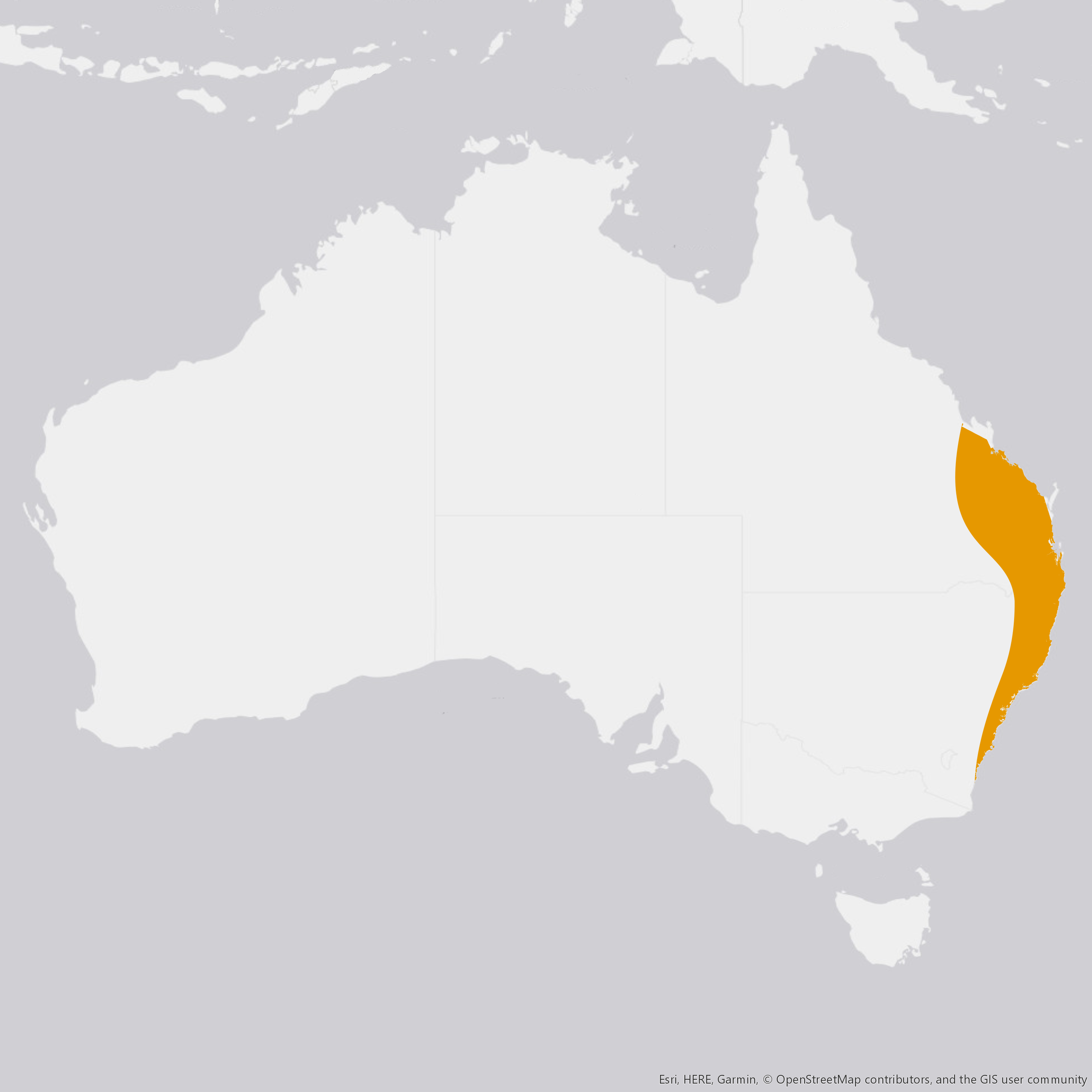
Variegated Fairywren range

This beautiful fairywren is best distinguished from the other chestnut-shouldered fairywrens by the bright blue and white females. The Lovely Fairywren is common but localized to the coast of the Cape York Peninsula, found in scrubby edge habitats. While a small number of males in other fairywren species may remain in their bright plumages through the entire year, Lovely Fairywrens are unique among Australian fairywrens, with all males retaining bright plumage throughout the year and never moulting into a dull plumage. As such, young males who have yet to adopt bright plumage are indistinguishable from females. Males and females are often seen in territorial spats chasing each other frantically and singing loudly in low canopies.
Bright Male Plumage: Bright males of the Lovely Fairywren are similar to other chestnut-shouldered fairywrens with blue crown, cheek, and upper back feathers. Cheeks more rounded than similar species. Throat, breast, lores, nape, and lower back black. Belly bright white. Wings brown with rufous scapulars. Blue tail shorter and with more prominent white tips than other chestnut-shouldered fairywrens. Outer tail feather edged with white.
Intermediate Male Plumage: Intermediate males are a cross between female plumage and bright male plumage. Lores and bill become black or near black, head and breast often moult first, giving the bird a patchy appearance.
Female and Juvenile Plumage: Head, back, and tail bright blue-grey, with brown-grey wings. Breast, throat, and stomach a pearly white. Lores and eye-ring white as well. Bill black. As in the bright male, female lovely-fairywrens have shorter tails relative to other chestnut-shouldered fairywrens with more prominent white-tips and a white-edge to the outer tail feathers.
Voice: Macaulay Library
Photographs: Macaulay Library
Explore Sightings: eBird
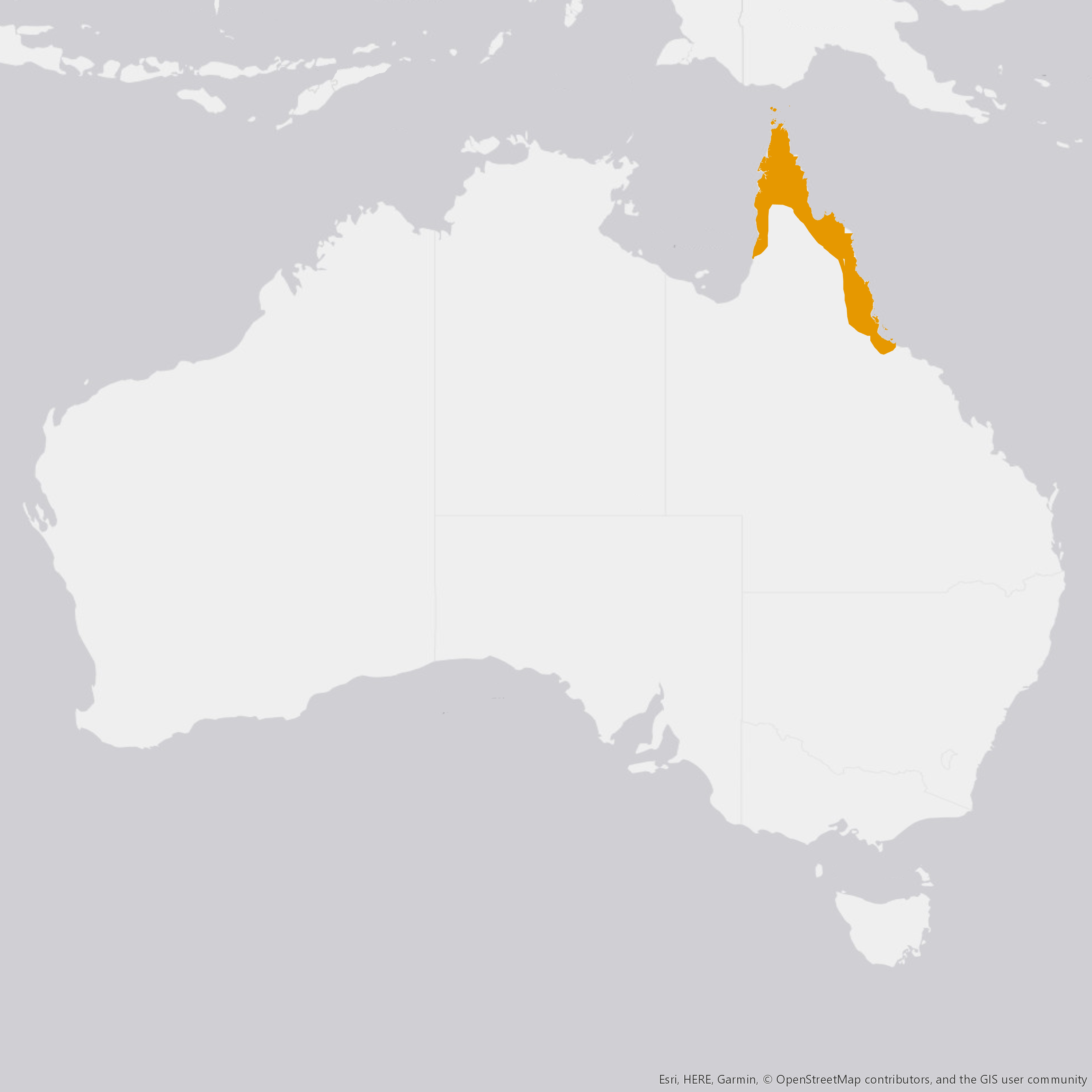
Lovely Fairywren range

Sporting the darkest blue head and cheek feathers of the chestnut-shouldered fairywrens, and the navy-blue breast that gives this species its name, males of the Blue-breasted Fairywren can be found foraging with their family groups in the understory of dry eucalyptus woodlands. This species can be found in two populations, one in a broad swath from the southwestern to southeastern Western Australia and another on the Eyre Peninsula of South Australia.
Bright Male Plumage: Similar to Purple-backed Fairywren, but crown and cheeks darker blue. Upper back dark blue. Deep blue of the breast apparent in good light, otherwise can look nearly black. Lower back similarly blue-black. Bill, lores, and nape black. Wings brown with rufous scapulars. Tail dark blue-grey and belly creamy-white.
Intermediate Male Plumage: Males moulting into bright plumage for the first time will often have bill and lores turn black first, older males will already have these traits present. Blue of head and breast appear in a manner similar to Variegated Fairywrens, giving intermediate males a patchy appearance.
Dull Male Plumage: Head and back light grey, wings and scapulars brown. Tail dark blue-grey, throat and belly creamy-white. Bill, lores, and legs black. Light blue-white eye-ring.
Female and Juvenile Plumage: Also similar to the Purple-backed Fairywren, females have grey-brown head, back and wings with creamy throat and tan belly. Tail blue-grey. Dark rufous lores and eye ring extending from a slightly lighter rufous bill.
Voice: Xeno-Canto
Photographs: Macaulay Library
Explore Sightings: eBird
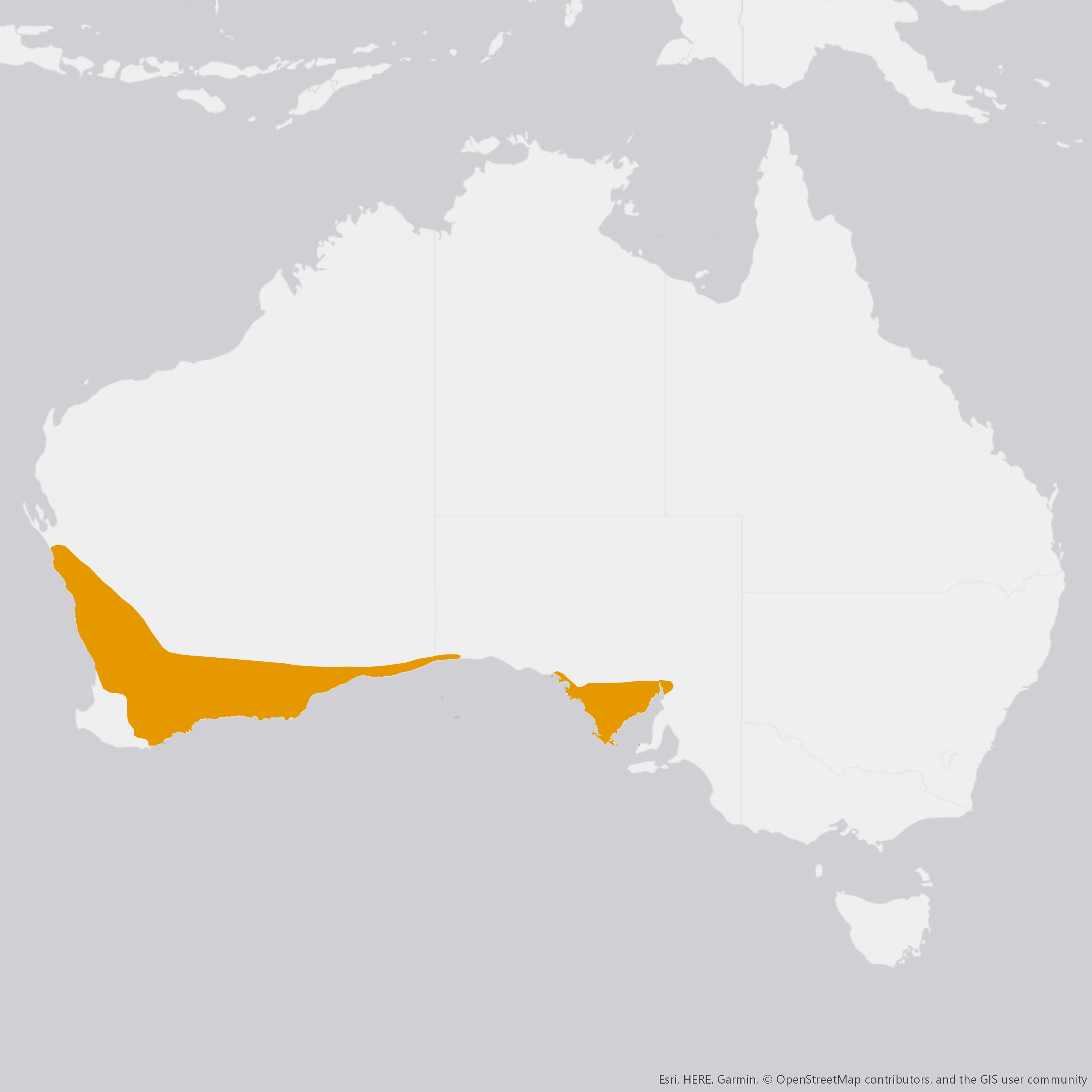
Blue-breasted Fairywren range
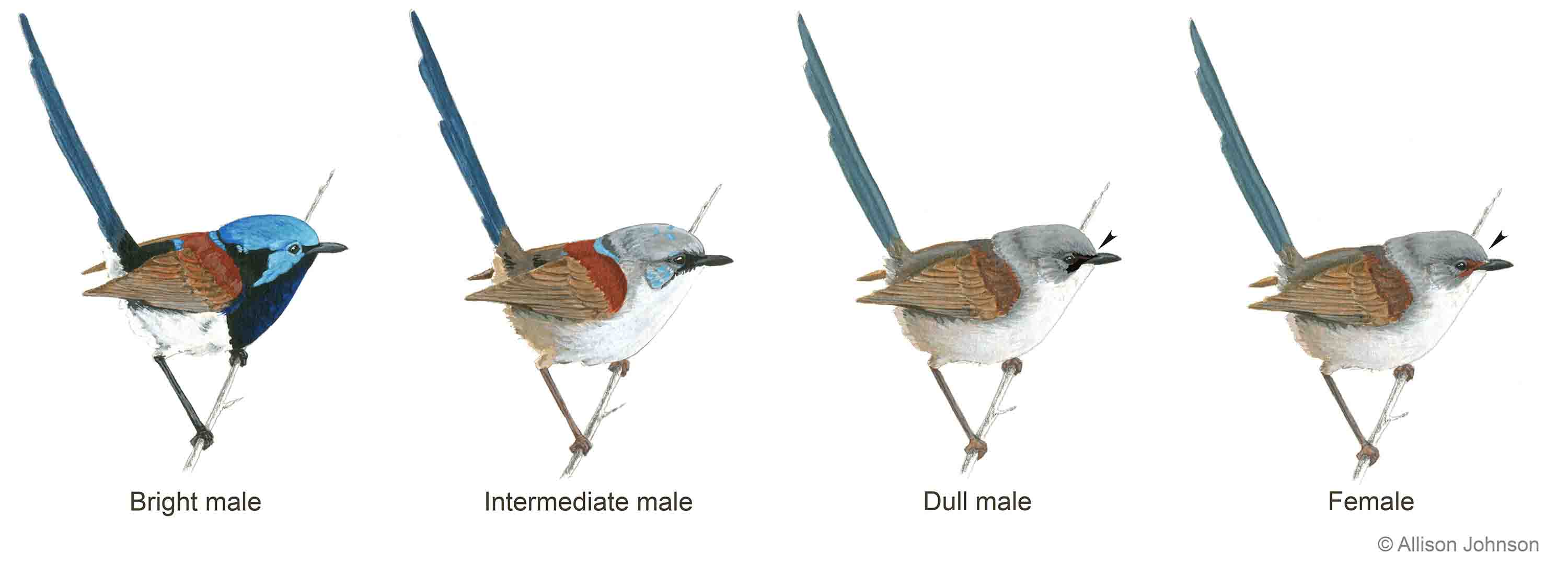
The Red-winged Fairywren is similar in appearance to the Blue-breasted Fairywren, but larger, exhibits the lightest blue crown and cheeks of the variegated clade, and prefers denser understory habitat. They are found exclusively in south-west Western Australia replacing the dry-country Blue-breasted Fairywren in the wet forests or woodlands of the Stirling and Darling ranges.
Bright Male Plumage: Similar to Blue-breasted Fairywren, with a dark, blue-black breast and lower back. Crown, cheeks, and upper back a bright light turquoise blue. Tail blue-grey. Wings brown with rufous scapulars. Belly creamy-white, grading to tan towards the tail.
Intermediate Male Plumage: As with the other chestnut-shouldered fairywrens, males will often not fully moult into bright breeding plumage their first year and can remain in intermediate plumage for several months. Males moulting into bright plumage for the first time will have the bill and lores turn black first. Both first year males and moulting males who have already completed at least one bright moult will then gain blue around the eye, head, and breast patchily, appearing a mottle of blue, black, and grey-white feathers while in the midst of moult.
Dull Male Plumage: Head and back light grey. Wings brown with rufous scapulars. Throat white, with creamy belly. Lores, bill, and legs black. Tail blue-grey.
Female and Juvenile Plumage: Head and lower back grey, shoulders and wings brown. Tail blue-grey. Throat and belly creamy-white with belly grading to tan towards the tail. Dark rufous lores and eye-ring extending from black bill. Note, only significant difference between females and dull males in the winter is the color of the lores: black in males and rufous in females.
Voice: Xeno-Canto
Photographs: Macaulay Library
Explore Sightings: eBird
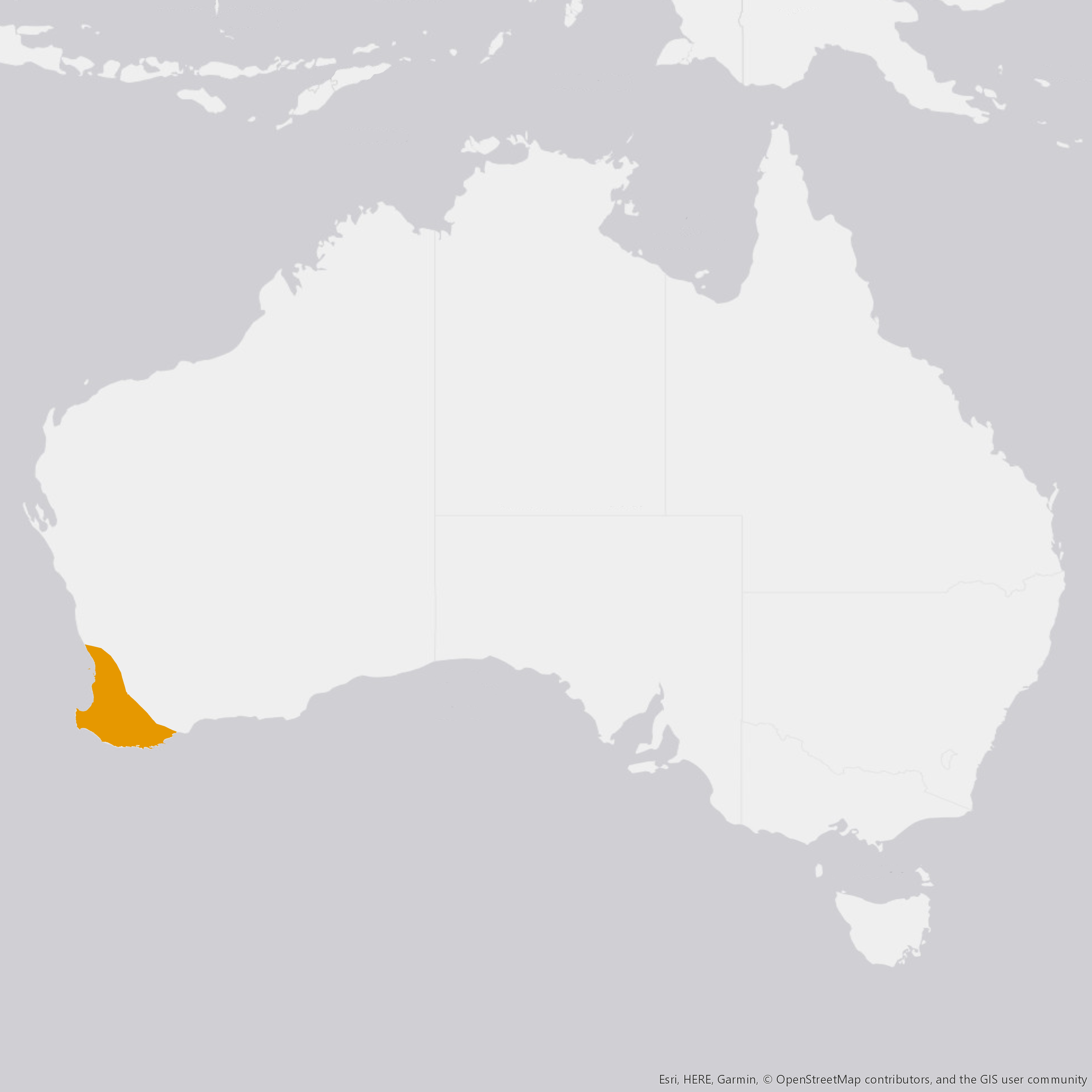
Red-winged Fairywren range
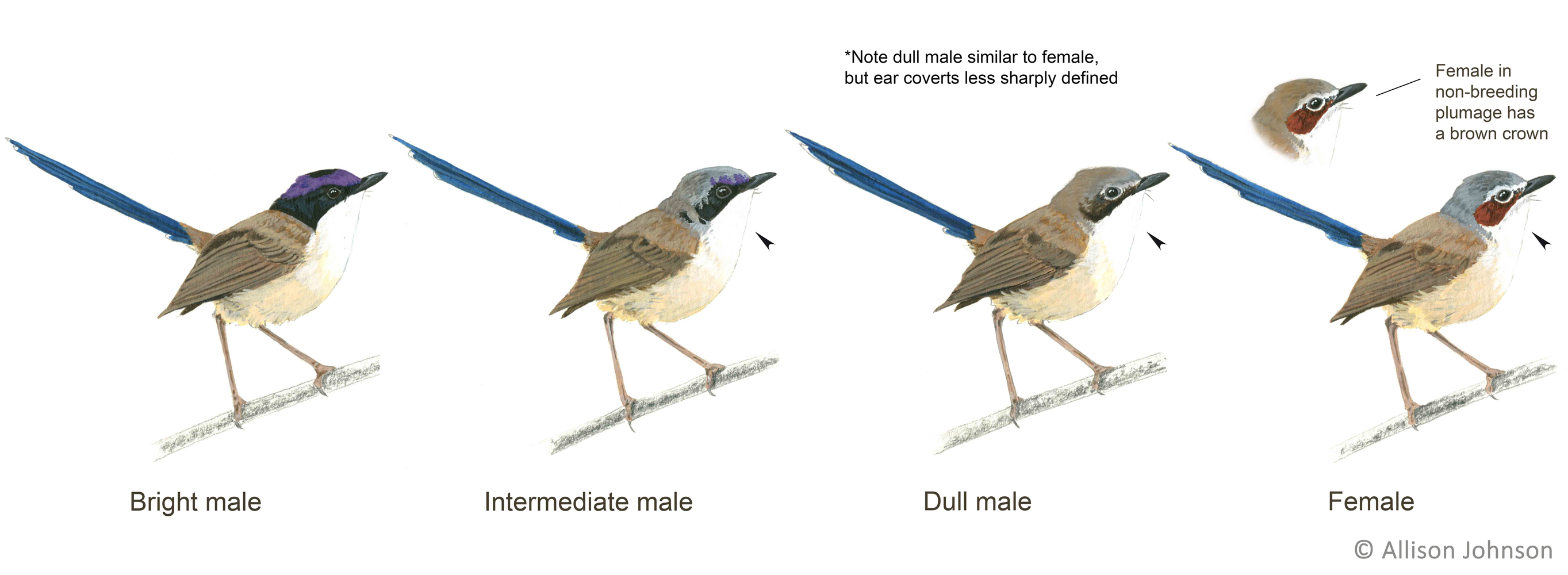
One of the most unique of the Australian fairywrens, the Purple-crowned Fairywren establishes territories in exclusively riparian habitat. The Purple-crowned Fairywren range forms two distinct subspecies, one in the riverine complexes of the Kimberly Range (M. c. coronatus) and one in the rivers of the southern Carpentarian Divide (M. c. macgillivrayi). Male and female duets of the loud, rather un-fairywren like song of this species can been heard while they defend year-round territories from intruders. Unlike most other fairywrens, the Purple-crowned Fairywren has low rates of extra-pair paternity and females, like males, moult into a non-breeding plumage in the winter.
Bright Male Plumage: Back and wings brown, tail blue. Throat creamy-white grading to tan along the belly towards the tail. Legs grey-pink. Black mask, nape, and bill. Brilliant purple crown interrupted by a black oval on top of head. M. c. coronatus has a solid purple crown, while the smaller M. c. macgillivrayi has a bluer crown and nape and whiter throat and belly.
Intermediate Male Plumage: Males moulting for the first time will have brown bills turn black first. Chestnut ear coverts will begin to fill in black. Males moulting into bright plumage from dull plumage lose the lighter supercilium and the purple crown will fill in from the bill toward the back of the head.
Dull Male Plumage: Similar to female, with brown crown and nape, supercilium lighter but not well defined white of females. Ear coverts black. Back and wings brown, tail blue-grey. Throat creamy-white grading to tan along the belly toward the tail. Bill black.
Female Plumage: Crown and nape light grey, eye-ring creamy-white , with distinct chestnut ear coverts. Back and wings brown, tail blue-grey. Throat creamy-white grading to tan along the belly towards the tail. Bill black.
Dull Female and Juvenile Plumage: Female Purple-crowned Fairywrens, like males, moult into a dull, non-breeding plumage, unlike other fairywren species. Females look similar to their breeding plumage except that their crown and nape are brown, not grey. Juveniles appear similar to females in dull plumage, and can be distinguished by the supercilium which is light but poorly defined in juveniles while creamy-white and well defined in females. Young juveniles can also be distinguished by shorter tails which grow in as they age. Females in breeding plumage and dull females can be recorded using the plumage code “f”.
Voice: Xeno-Canto
Photographs: Macaulay Library
Explore Sightings: eBird
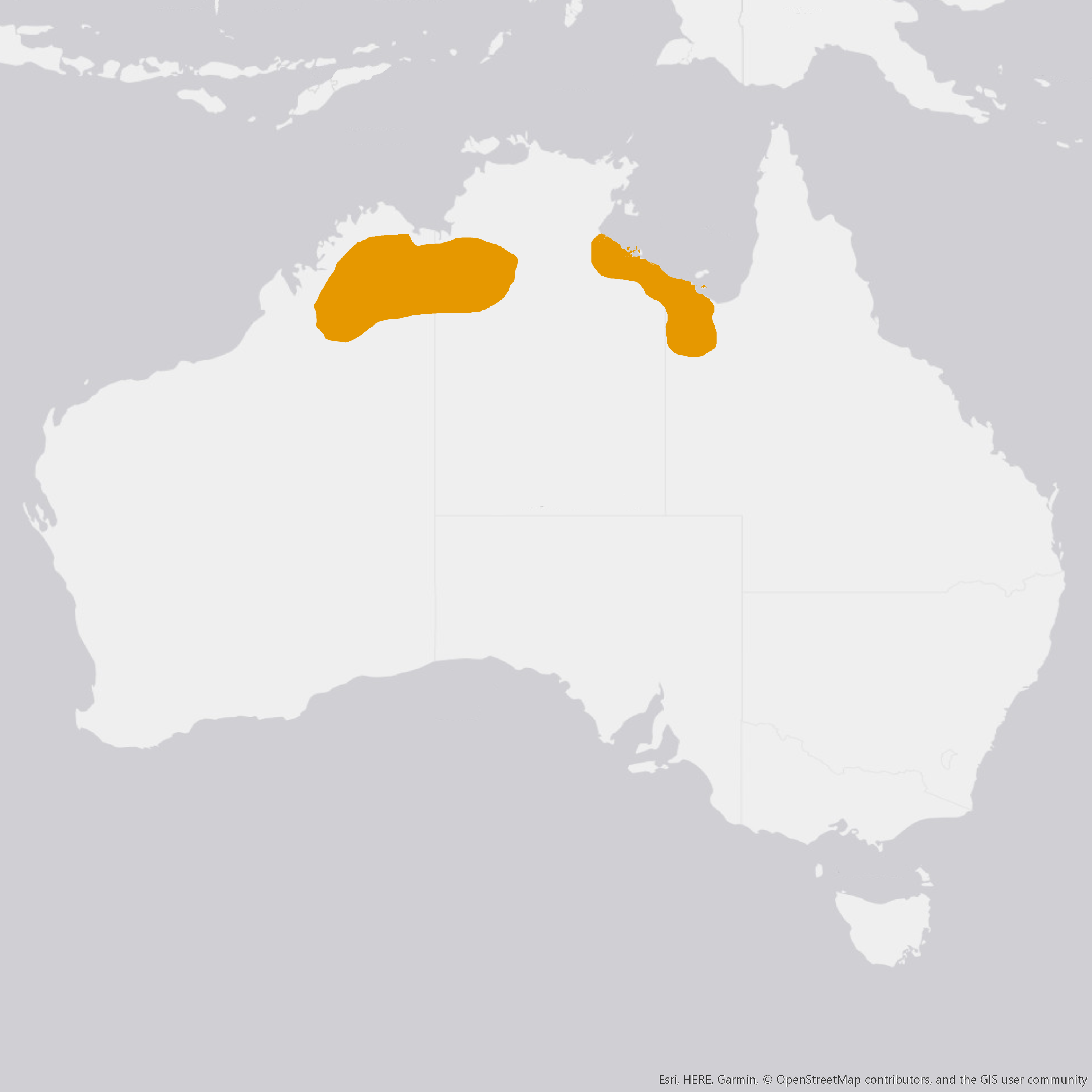
Purple-crowned Fairywren range
Range maps made in ArcGIS Pro with data available from BirdLife International: BirdLife International and Handbook of the Birds of the World (2017) Bird species distribution maps of the world. Version 7.0. Available at http://datazone.birdlife.org/species/requestdis


